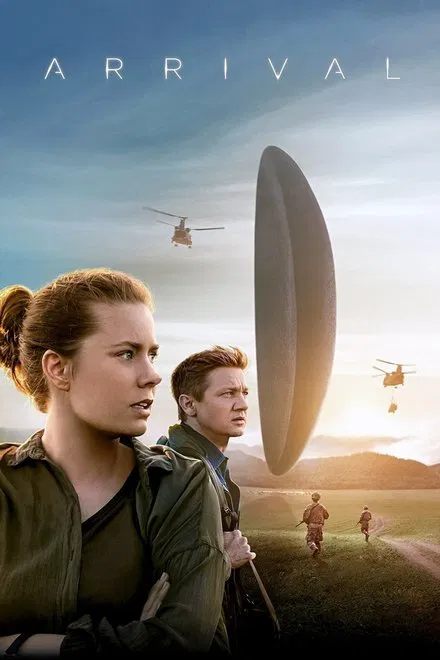
Directed by: Denis Villeneuve
Starring: Amy Adams, Jeremy Renner, Forest Whitaker
🚀 Introduction: Language, Time, and the Unknown
Arrival is not a conventional alien invasion film. Instead, Denis Villeneuve’s adaptation of Ted Chiang’s story “Story of Your Life” blends science fiction with deep philosophical questions about language, fate, and memory. The narrative follows Dr. Louise Banks, a linguist tasked with decoding the language of mysterious extraterrestrials who land at twelve locations around the globe. The story’s non-linear structure, enigmatic visuals, and emotional resonance make it both mind-bending and deeply human.
🛸 The Arrival: Contact and Uncertainty
One morning, twelve massive, monolithic alien vessels arrive at seemingly random spots around the world. Each country responds with military readiness, fear, and confusion. In the United States, Colonel Weber recruits linguist Louise Banks and physicist Ian Donnelly to Montana, where one ship floats above a field, casting a shadow over the world’s sense of security. Initial encounters are tense, with humans entering the ship’s “shell” only at scheduled intervals.
Louise and Ian are taken into the ship’s gravity-defying interior, where they meet the Heptapods—two seven-limbed, ink-spewing creatures. Separated by glass, the two species struggle to communicate. The military’s patience is limited; world powers share only partial data, and paranoia spreads. Louise insists that understanding the aliens’ language—what they want, and why they’re here—must come before any action.
📝 Decoding the Language: Heptapod B
Louise’s methodical, compassionate approach gradually earns the Heptapods’ trust. She exchanges names, gestures, and written symbols. The Heptapods’ written language (“Heptapod B”) is unique: circular, non-linear, and visually complex, with each logogram containing an entire sentence’s worth of meaning. Louise and Ian painstakingly decode the patterns, cataloging hundreds of logograms, learning new concepts daily.
As Louise learns Heptapod B, she begins experiencing vivid visions—apparently memories—of a daughter, Hannah, who grows up, suffers, and dies young of a rare disease. The film cleverly interweaves these “memories” with the present, creating a sense of emotional mystery that deepens as the plot progresses.
⏳ Nonlinear Time: The Big Reveal
The Heptapods’ language, Louise realizes, rewires the mind of anyone who masters it. Their perception of time is not linear—past, present, and future coexist. The “memories” of Hannah are not flashbacks, but flash-forwards: glimpses of a life that has not yet happened. By thinking in Heptapod B, Louise can “remember” the future, experiencing her daughter’s entire life before it unfolds.
This revelation fundamentally shifts the film’s narrative and themes. The Heptapods are not here to attack or enslave, but to share their gift—their language, and thus their perception of time—with humanity. Louise realizes that learning the language enables her to see the totality of her existence, joys and sorrows alike.
🌏 Global Crisis: War and Communication
As world powers race to decode the Heptapods’ purpose, mistrust grows. China, Russia, and other nations interpret the aliens’ message as a threat (“offer weapon”), and prepare for war. In Montana, Louise pushes for one more contact, convinced there is a deeper meaning.
The Heptapods “speak” to her alone, explaining that humanity must work together—and that in 3,000 years, they will need humanity’s help. Their “weapon” is their language: a tool for uniting the world, not destroying it.
🔑 The Power of Choice: Louise’s Decision
Armed with knowledge of the future, Louise faces an impossible choice. She uses her new perception to “remember” a future phone call to General Shang of China, delivering a message that averts global war. This creates a paradox: Louise’s understanding of the future shapes her present actions, which in turn create the future she “remembers.”
The film’s closing moments are bittersweet. Louise chooses to embrace the love and pain she knows are coming—her relationship with Ian, the birth and loss of Hannah—believing that every moment, no matter how fleeting or tragic, is worth living. The circular nature of time, reflected in the Heptapods’ logograms, becomes a metaphor for acceptance, love, and the mystery of existence.
🎬 Final Thoughts: Meaning, Loss, and Humanity
Arrival is a film that asks: if you could see your entire life laid out before you, would you change anything? Its non-linear storytelling is not just a gimmick, but a meditation on fate, grief, and the human desire for connection. Amy Adams’s performance, Denis Villeneuve’s direction, and Jóhann Jóhannsson’s haunting score elevate the film into an emotionally resonant masterpiece.
The true “weapon” is empathy—language as a bridge across space, time, and loss. By choosing love despite inevitable pain, Louise’s story becomes a universal human fable, as mysterious and beautiful as the Heptapods themselves.